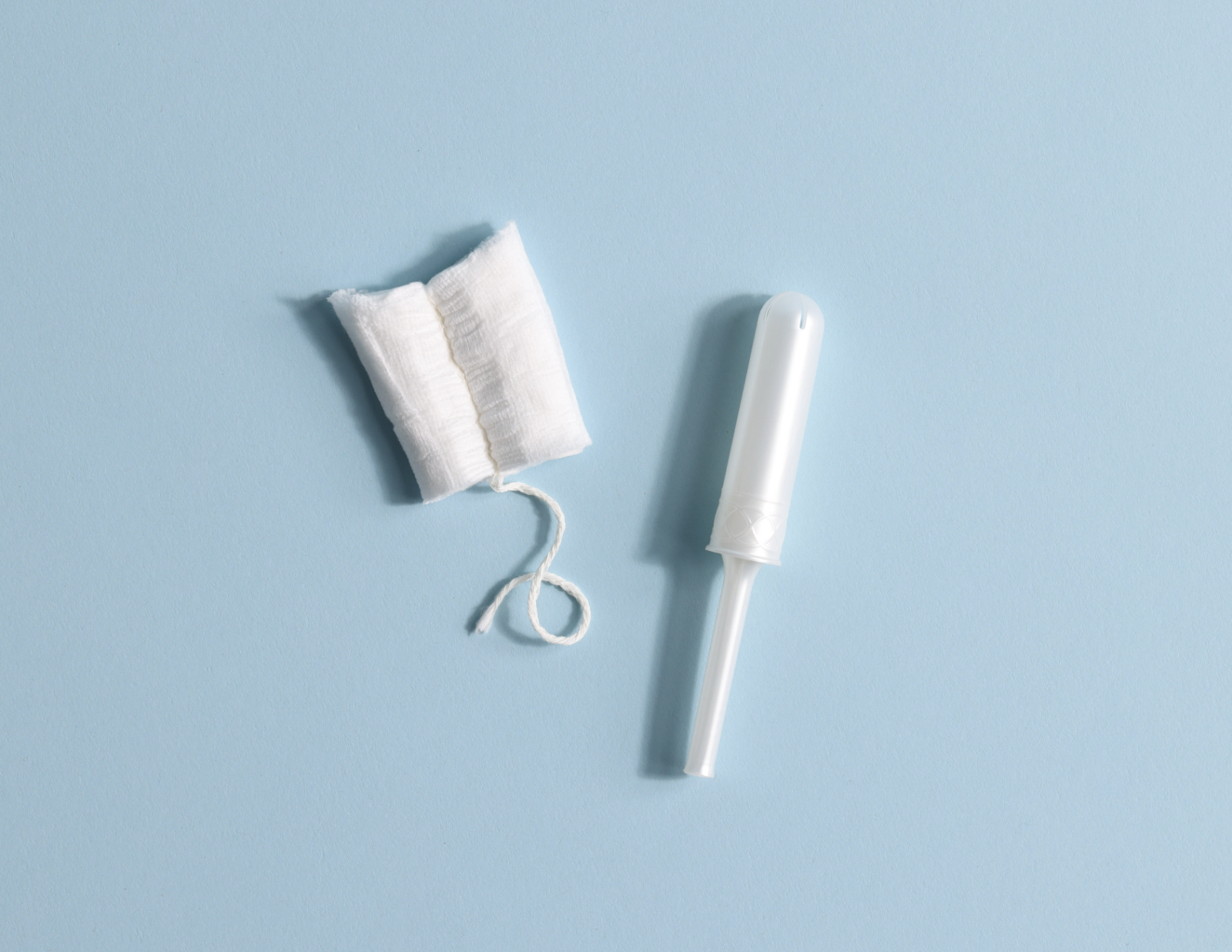•
•
•
•
•
•
•
•
•
•
•
•
•
•
•
•
•
•
•
•

How to Use a Tampon: A Guide for First Time & Regular Users
Tampon 101!

Using a tampon for the first time can be scary, we get it!. In this Tampons 101 page we are going to walk you through any and all of your tampon related questions. Trust us, by the end of this article we just know you’ll be ready to make tampons your newest period BFF.
What is a tampon?

In its simplest form, a tampon is a wad of cotton used to absorb blood in your vaginal canal during your period. The best organic tampons are made of 100% organic cotton that’s free of fragrances, dyes, pesticides and harsh chemicals that you want to keep out of your most intimate area. They come in lots of shapes, sizes and applicator styles for you to find your perfect fit. It is small enough to get inserted inside of you and is different from a pad which is attached to your underwear and stays on the outside of your vagina.
How do tampons differ from panty liners and pads?
Liners and pads are completely different from tampons in terms of how the product is actually used. Tampons are internal; they’re inserted in the vaginal canal while pads & liners are external; they simply rest on the menstruator’s underwear to absorb blood that flows out. Tampons are also less absorbent and need to be changed more frequently. August organic cotton tampons are sized at light (~3-5ml), regular (~5-8ml), and super (~10ml). Our organic cotton pads are sized at day pads (60mL), night pads (80mL), and liners (10mL).
How long can you leave a tampon in?
You’ll get to know your regular flow with more practice, but changing it more often is always better! With tampons, 4-6 hours is recommended and 8 hours is the max. The reason there is a time cap to wearing a tampon is to reduce the risk of Toxic Shock Syndrome (TSS). TSS can occur when a tampon is worn for too long. It is extremely rare, but still something to take seriously. Pads do not have a risk of TSS, but it is still good practice and more comfortable for you to change them often.
How do you use a tampon?

They come in different absorbencies: light, regular, and super. It’s best to use the lowest or lightest absorbency that lasts you a few hours. Some come with applicators — small sticks made of cardboard or plastic that help you put the tampon in your vagina. And some don’t have an applicator, so you just put them in with your fingers.
August period care covers the pink tax on our 100% organic cotton tampons that are fully biodegradable and open axially like a pair of angel wings to most comfortably fit the shape of your vagina. They are fitted with BPA-free plastic long-applicators for easy insertion.
Here are some steps to inserting your first tampon (With an applicator) This process is a lot more comfortable if you’re relaxed– so take a deep breath you’ve got this! For first timers, using tampons with smooth, rounded applicators may make it easier. You can also put a little bit of lubricant on the tip of the tampon or applicator. If you’re having trouble, ask someone you trust (like your mom, sister, or another person you trust) to help coach you through it. Wash your hands and get into a comfortable position. You can squat, put one leg up, or sit on the toilet with your knees apart. Push the tampon into your vagina using the applicator or your finger, depending on what kind you have. You might be wondering which hole to put it in or if you can accidentally enter it into the wrong hole. These are completely normal questions! The tampon goes into the vaginal opening which is between the urethra (where the pee comes out) and the anus. The vaginal opening usually has the shape of an oval rather than a round circle. Throw the wrapper and applicator in the trash — don’t flush them as the waste can clog your pipes and run into nearby waterways. It’s best to change your tampon every 4-8 hours to reduce the risk of TSS. You can wear a tampon overnight, but put it in right before bed and change it as soon as you get up in the morning. One inserted you will notice a string hanging out of your vagina. Pull it to gently remove it when it's time to put in a new one. It’s easier to take your tampon out when it’s wet from absorbing the max amount of period flow it can. Wrap used tampons in toilet paper and throw them away in the trash — again, don’t flush them!! How to insert a cardboard tampon? See above: You can insert it the same way you would using a plastic applicator.
Can you pee with a tampon in?
Yes you absolutely can! Your pee hole and the hole your tampon goes into are two completely different holes so there’s no issue there. The string might get in the way but that’s no big deal. Just be sure to change your tampon every 4-6 hours like normal.
Can you poop with a tampon in?
Again, yes you can, but if you’d prefer not to, just take out the tampon and change it out for another. There’s no health risk to having one in when you poop - it might just be annoying. Don’t be alarmed if the product does pop out from pushing too hard - just put a new one in! Also, just make sure you’re keeping the string clean when wiping so as not to spread any bacteria.
What hole does a tampon go into?

You have three holes down there: the urethra, vaginal canal, and anus. You could only realistically put a tampon into ⅔ of those–your vaginal canal or anus. Tampons go into the second hole (vagina canal) on your vulva. You know you’ve gone too far if you attempt to insert it into your anus (butthole!).
Can you swim with a tampon in?

This type of period care is perfect to wear while swimming or spending the day at the beach! You might have a little leakage because, contrary to myths, your flow does not completely stop in the water (it is reduced, but not stopped). But, at least you’ll have a safeguard for when you get out of the water. Just don't get distracted building sandcastles and remember to change it... Also, swimming on your period is actually good exercise and may even relieve cramps.
Can a tampon get lost?
It’s not possible for it to get completely lost inside of you. However, until you remove the tampon, it will stay inside of you. Your cervix is the only other opening in your vagina but it’s too small for this menstrual product to pass through.
How to get a stuck tampon out?
The best way to remove the tampon is to pull on the string that is on the bottom end of it. If you really can’t manage to get it out then call your doctor or a sexual health clinic. Remember that this type of period care should ideally be taken out at the 6-hour mark!
Is it bad to sleep with a tampon in?

As long as you are able to change it before bed, and right when you wake up, then it’s okay to sleep with it in. Remember, depending on your flow, it will hold more or less blood, and it’s recommended to change every 4-8 hours. Dr. Heather Irobunda from the August Medical Board wanted to remind everyone to also read and follow the manufacturer’s instructions when using this type of period care. If you’re an August subscriber peep the inside of your tampon box, we provide handy leaflets that even have diagrams on how to insert a tampon.
What happens if you leave a tampon in too long?

The first thing that will happen if you leave one in for too long is that your flow might leak onto your clothes. Your vagina will likely feel uncomfortable and in rare cases you’ll be at risk of developing Toxic Shock Syndrome (TSS). TSS is a serious, life-threatening condition caused by bacteria getting into the body and producing bad toxins. Fun fact though: strep throat is actually a more common cause of TSS than tampon use! Just remember to change it out often and get to know your flow!
When was the tampon invented?
Most sources credit Colorado-based general practitioner Earle Cleveland Haas with patenting the first commercial applicator tampon. Prior to that, people with periods would makeshift methods of absorption, until pads eventually became mainstream. Supposedly, one method used was a condom with holes poked through that had a pad inside…Thankfully, Haas got inspiration from a) a friend of his who mentioned having to insert a piece of sponge to absorb menstrual flow and b) the bulkiness of pads that his ballerina wife had to wear. From there, he developed an insertable piece of compressed cotton plus the first iteration of cardboard applicators. In 1933, he patented his product as ‘Tampax’. The applicator transformed the conversation about how interrelated tampons were to sex and the “breaking of the hymen”. Tampons became a menstrual staple once people other than men were doing more physical activity during WW2. There have been many small changes to the modern tampon design but generally speaking, the tampon that we know and love continues to absorb in the same way as it did nearly 100 years ago.
Can I shower with a tampon?
Similar to swimming on your period, you can totally shower with this type of menstrual product in or shower without any products at all– It’s your choice!
How far should a tampon go in?

It should go in as far as the applicator base allows it to (August’s BPA-free applicators are about 40-50mm). As long as it feels comfortable, and you can confidently pull on the string, it should be okay. If your tampon isn’t far enough in there you will be able to feel it at the opening of your vaginal canal– this friction is why a lot of people think tampons are uncomfortable so be sure to try pushing it in further if you’re experiencing discomfort.
Can a tampon break your hymen?
Yes, a tampon could 'break' your hymen but it's nothing to be too concerned about.The hymen is just a thin layer of skin so it is common to be worn down gradually by other physical activities (i.e. horseback riding, riding bikes, gymnastics, climbing trees, running, or even dancing). By the time you put a tampon in, it will likely already be much thinner. This type of period product works equally as well for people who have or haven’t had sex.
If I use a tampon am I still a virgin?
Using a tampon doesn’t ‘take away’ your virginity. Only your first (consensual) sexual experience with someone can do that, and that should be completely at your discretion. A tampon is officially a medical device so your period doesn’t change your virginity status. Even if it stretches your hymen, virginity is related to sexual intercourse and not using this type of period care. This model of period care works equally well for people who have or haven’t had sex. Also for a quick myth buster: there is NO way for a doctor to be able to tell if you have or havent had sex!
Do tampons make cramps worse?

According to Dr. Saru Bala, tampons can worsen cramps for some people. It’s not always related, but for those with pelvic floor dysfunction, tampons can create more pain. If you also have pain with intercourse, that’s a sign the issue may be a pelvic floor issue. Switching to organic, unbleached, and non-toxic/ fragrance-free tampons have also been helpful for a lot of people who use period products. If that still doesn’t help, then switching to a pad may be helpful.
Do tampons hurt?
This is the most common question we get when it comes to tampons, and if done right the answer should be a 100% no they don’t! If you are experiencing pain when putting in a tampon our guess is one of three things is happening: you have the wrong size tampon, the tampon is too dry, or the tampon hasn’t been inserted correctly. Let’s start with size. Tampons come in light, regular, super, super plus, and ultra. If you select a size that is too large for your flow, your tampon won't be fully saturated with blood and the dryness might be making it uncomfortable to remove. That leads us into reason number two, your tampon being too dry. If your tampon is too dry upon insertion or removal, this could be what is causing you discomfort. For dryness when inserting a tampon, lots of menstruators will use lubrication to help get them used to tampons when they’re first starting out. If your tampon is too dry when removing it, that means you might have the wrong size. Consider sizing down to fix this problem! The final thing that might be causing you discomfort with tampons is that you haven't inserted it correctly. If you can feel your tampon at the opening of your vagina, then it’s not in there far enough! You shouldn’t be able to feel your tampon at the opening of your vaginal canal. If it’s not in there far enough you might be feeling a bit of friction. If after trying these tips, if you are still experiencing pain with a tampon, consider talking to your doctor as you may have a condition that causes pelvic floor dysfunction.